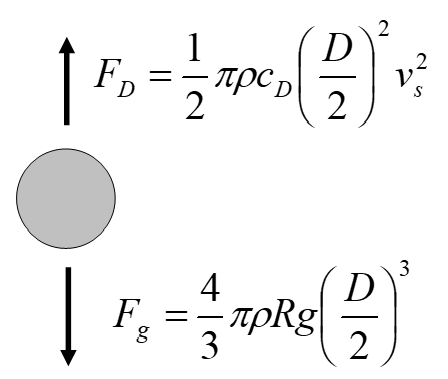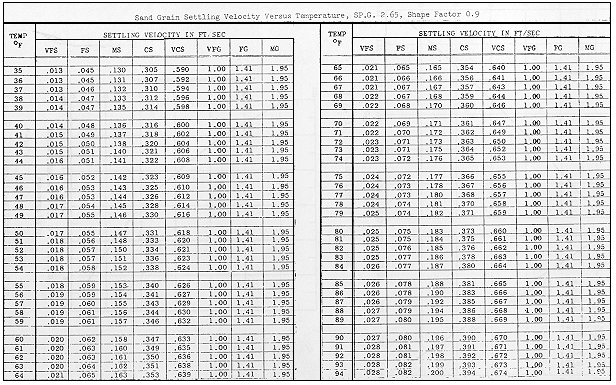Download PDF
Download page Fall Velocity and Settling.
Fall Velocity and Settling
Fall Velocity is also used in several of the Sediment Settling Methods for the reservoir element. The available methods for calculating fall velocity include Report 12 (Interagency Committee, 1957), Rubey (1933), Toffaleti (1968), and Van Rijn (1993). The default selection is Rubey.
Most fall velocity derivations start with balancing the gravitational force and the drag force on a particle falling through the water column. The free body diagram is included in the figure below.
However, the resulting equation is circular because fall velocity is function of the drag coefficient CD, which is a function of the Reynolds number, which is itself a function of fall velocity. This self-referential quality of the force balance requires either an approximation of the drag coefficient/Reynolds number or an iterative solution. The fall velocity options in HEC-RAS are detailed in Chapter 12, pages 12-30 to 12-32, but a few brief comments on how each of these methods attempts to solve this equation (fall velocity dependence on fall velocity) are given below.
Rubey assumes a Reynolds number to derive a simple, analytical function for fall velocity. Toffaleti developed empirical, fall velocity curves that, based on experimental data, which HEC-RAS reads and interpolates directly. Van Rijn uses Rubey as an initial guess and then computes a new fall velocity from experimental curves based on the Reynolds number computed from the initial guess. Finally, Report 12 is an iterative solution that uses the same curves as Van Rijn but uses the computed fall velocity to compute a new Reynolds number and continues to iterate until the assumed fall velocity matches the computed within an acceptable tolerance.
Fall velocity is also dependent upon particle shape. The aspect ratio of a particle can cause both the driving and resisting forces in Figure 2 9 to diverge from their simple spherical derivation. All of the equations assume a shape factor or build one into their experimental curve. Only Report 12 is flexible enough to compute fall velocity as a function of shape factor. Therefore, HEC-RAS exposes shape factor as a user input variable but only uses it if the Report 12 method is selected.
For a more comprehensive understanding, including information on algorithms that translate hydrodynamics into transport, please refer to the "Sediment Transport Capacity". This reference is relevant because HEC-HMS shares the same Sediment Transport engine as HEC-RAS.
Comprehensive information on fall velocity methods is provided in the HEC-RAS Hydraulic Reference Manual, as illustrated below.
The suspension of a sediment particle is initiated once the bed-level shear velocity approaches the same magnitude as the fall velocity of that particle. The particle will remain in suspension as long as the vertical components of the bed-level turbulence exceed that of the fall velocity. Therefore, the determination of suspended sediment transport relies heavily on the particle fall velocity.
Within HEC-RAS, the method for computing fall velocity can be selected by the user. Three methods are available and they include Toffaleti (1968), Van Rijn (1993), and Rubey (1933). Additionally, the default can be chosen in which case the fall velocity used in the development of the respective sediment transport function will be used in RAS. Typically, the default fall velocity method should be used, to remain consistent with the development of the sediment transport function, however, if the user has specific information regarding the validity of one method over the other for a particular combination of sediment and hydraulic properties, computing with that method is valid. The shape factor (sf) is more important for medium sands and larger. Toffaleti used a sf of 0.9, while Van Rijn developed his equations for a sf of 0.7. Natural sand typically has a sf of about 0.7. The user is encouraged to research the specific fall velocity method prior to selection.
| \displaystyle sf= \frac{c}{\sqrt{ab}} |
| Symbol | Description | Unit |
|---|---|---|
a | Length of particle along the longest axis perpendicular to the other two axes. | |
b | Length of particle along the intermediate axis perpendicular to other two axes. | |
c | Length of particle along the short axis perpendicular to other two axes. |
Particle Settling Velocity
Toffaleti
Toffaleti (1968) presents a table of fall velocities with a shape factor of 0.9 and specific gravity of 2.65. Different fall velocities are given for a range of temperatures and grain sizes, broken up into American Geophysical Union standard grain size classes from Very Fine Sand (VFS) to Medium Gravel (MG). Toffaleti's fall velocities are presented in Table below.
Fall Velocity (Toffaleti, 1968)
Van Rijn
Van Rijn (1993) approximated the US Inter-agency Committee on Water Resources' (IACWR) curves for fall velocity using non-spherical particles with a shape factor of 0.7 in water with a temperature of 20oC. Three equations are used, depending on the particle size:

where
ν = kinematic viscosity [L2/T]
d = grain size [L]
d∗ = d(Rg)1/3ν−2/3 = dimensionless grain size [-]
R = ρs/ρw−1 = submerged specific gravity [-]
ρs = particle density [M/L3]
ρw = water density [M/L3]
g = gravitational constant (~9.81 m/s2) [L/T2]
Rubey
Rubey (1933) developed an analytical relationship between the fluid, sediment properties, and the fall velocity based on the combination of Stoke's law (for fine particles subject only to viscous resistance) and an impact formula (for large particles outside the Stoke's region). This equation has been shown to be adequate for silt, sand, and gravel grains. Rubey suggested that particles of the shape of crushed quartz grains, with a specific gravity of around 2.65, are best applicable to the equation. Some of the more cubic, or uniformly shaped particles tested, tended to fall faster than the equation predicted. Tests were conducted in water with a temperature of 16∘ Celsius.
| \displaystyle \omega = F_1 \sqrt{(s-1)gd_s} |
in which
| \displaystyle F_1 = \sqrt{\frac{2}{3} + \frac{36 \nu ^2}{gd^3 (s-1)}} - \sqrt{\frac{36 \nu ^2}{gd^3(s-1)}} |
where
ν = kinematic viscosity [L2/T]
g = gravitational constant (~9.81 m/s2) [L/T2]
d = grain size diameter [L]
R = ρs/ρw−1 = submerged specific gravity [-]
ρs = particle density [M/L3]
ρw= water density [M/L3]
The parameter F1 has an upper limit of 0.79 which corresponds to particles larger than 1 mm settling in water with temperatures between 10 and 25∘C. The Rubey formula is one of the earliest sediment fall velocity formulas developed. However, it tends to significantly under-predict the fall velocity for sediments courser than fine sand.
Hindered Settling
Hindered settling is the condition in which the settling velocity of particles or flocs is reduced due to a high concentration of particles. Hindered settling is primarily produced by particle collisions and the upward water flow equal to the downward sediment volume flux. Hindered settling occurs to both cohesive and noncohesive particles. However, the hindered settling correction described here only applies to noncohesive particles. When the sediment concentration is high (approximately larger than 3,000 mg/l), the settling of particles is reduced due to return flow, particle collisions, increased mixture viscosity, increased buoyancy, and wake formation. This process is referred to as hindered settling.
Richardson and Zaki
When using other particle settling velocities hindered settling is considered using a modified form of Richardson and Zaki (1952) (Hindered Settling).

where![]() = sediment particle settling velocity for turbid water [L/T]
= sediment particle settling velocity for turbid water [L/T]![]() = sediment particle settling velocity for clear water [L/T]
= sediment particle settling velocity for clear water [L/T]![]() = total sediment concentration by volume [-]
= total sediment concentration by volume [-]![]() = empirical exponent [-]
= empirical exponent [-]
The empirical coefficient ![]() ranges between 3.75 to 4.45 for medium to fine sands (approximately 4.0 for normal flow conditions and particles in the range of 0.05 to 0.5mm) The above formulation differs from Richardson and Zaki (1952) in the inclusion of the maximum suspended sediment concentration which may be set to the bed dry density. This is physically correct since the particle velocity should become zero when the concentration is equal to the bed dry density. The empirical exponent that varies from is a function of the particle Reynolds number but is set to user-defined constant here for simplicity.
ranges between 3.75 to 4.45 for medium to fine sands (approximately 4.0 for normal flow conditions and particles in the range of 0.05 to 0.5mm) The above formulation differs from Richardson and Zaki (1952) in the inclusion of the maximum suspended sediment concentration which may be set to the bed dry density. This is physically correct since the particle velocity should become zero when the concentration is equal to the bed dry density. The empirical exponent that varies from is a function of the particle Reynolds number but is set to user-defined constant here for simplicity.
Kumbhakar
When using other particle settling velocities hindered settling is considered using a modified form of Kumbhakar (2017).

where
ωn = Hindered settling velocity in mixture
ω0 = Settling velocities of particles in clear fluid
c = Volumetric concentration of suspended sediment particle
R = Particle Reynolds number
Δp = Submerged specific weight